Time Series Ovarian Transcriptome Analyses of the Porcine Estrous Cycle Reveals Gene Expression Changes during Steroid Metabolism and Corpus Luteum Development
Abstract
:Simple Summary
Abstract
1. Introduction
2. Materials and Methods
2.1. Ethics Statement
2.2. Animals and Sampling
2.3. RNA Extraction, Library Preparation, and Sequencing
2.4. Data Processing and DEG Identification
2.5. Functional Validation of DEG
2.6. Gene Modulation in the KEGG Pathway Analysis
3. Results and Discussion
3.1. Integrative RNA-seq Analysis and DEG Profiling during the Estrous Cycle
3.2. Functional Annotations and Enriched Pathway Analyses in Clusters
3.2.1. Reproductive Hormones in Luteal Phase
3.2.2. Immune Responses in Luteal Phase
3.2.3. Cell Proliferation and Growth in Luteal Phase
4. Conclusions
Supplementary Materials
Author Contributions
Funding
Institutional Review Board Statement
Informed Consent Statement
Data Availability Statement
Acknowledgments
Conflicts of Interest
References
- Soede, N.; Langendijk, P.; Kemp, B. Reproductive cycles in pigs. Anim. Reprod. Sci. 2011, 124, 251–258. [Google Scholar] [CrossRef]
- Zhang, X.; Huang, L.; Wu, T.; Feng, Y.; Ding, Y.; Ye, P.; Yin, Z. Transcriptomic analysis of ovaries from pigs with high and low litter size. PLoS ONE 2015, 10, e0139514. [Google Scholar]
- Zhang, F.P.; Ran, X.Q. Changes in Ovary Transcriptome and Alternative splicing at estrus from Xiang pigs with Large and Small Litter Size. bioRxiv 2019, 547810. [Google Scholar] [CrossRef]
- Meurens, F.; Summerfield, A.; Nauwynck, H.; Saif, L.; Gerdts, V. The pig: A model for human infectious diseases. Trends Microbiol. 2012, 20, 50–57. [Google Scholar] [CrossRef] [PubMed]
- Edson, M.A.; Nagaraja, A.K.; Matzuk, M.M. The mammalian ovary from genesis to revelation. Endocr. Rev. 2009, 30, 624–712. [Google Scholar] [CrossRef]
- Chu, Q.; Zhou, B.; Xu, F.; Chen, R.; Shen, C.; Liang, T.; Li, Y.; Schinckel, A.P. Genome-wide differential mRNA expression profiles in follicles of two breeds and at two stages of estrus cycle of gilts. Sci. Rep. 2017, 7, 5052. [Google Scholar]
- Yang, S.; Zhou, X.; Pei, Y.; Wang, H.; He, K.; Zhao, A. Identification of differentially expressed genes in porcine ovaries at proestrus and estrus stages using RNA-Seq technique. BioMed Res. Int. 2018, 2018, 8. [Google Scholar] [CrossRef] [PubMed]
- Kim, J.-M.; Park, J.-E.; Yoo, I.; Han, J.; Kim, N.; Lim, W.-J.; Cho, E.-S.; Choi, B.; Choi, S.; Kim, T.-H. Integrated transcriptomes throughout swine oestrous cycle reveal dynamic changes in reproductive tissues interacting networks. Sci. Rep. 2018, 8, 5436. [Google Scholar] [CrossRef]
- Tanski, D.; Skowronska, A.; Tanska, M.; Lepiarczyk, E.; Skowronski, M.T. The In Vitro Effect of Steroid Hormones, Arachidonic Acid, and Kinases Inhibitors on Aquaporin 1, 2, 5, and 7 Gene Expression in the Porcine Uterine Luminal Epithelial Cells during the Estrous Cycle. Cells 2021, 10, 832. [Google Scholar] [CrossRef] [PubMed]
- Murray, F., Jr.; Bazer, F.W.; Wallace, H.; Warnick, A. Quantitative and qualitative variation in the secretion of protein by the porcine uterus during the estrous cycle. Biol. Reprod. 1972, 7, 314–320. [Google Scholar] [CrossRef]
- Buhi, W.; Vallet, J.; Bazer, F. De novo synthesis and release of polypeptides from cyclic and early pregnant porcine oviductal tissue in explant culture. J. Exp. Zool. 1989, 252, 79–88. [Google Scholar] [CrossRef] [PubMed]
- Srikanth, K.; Kwon, A.; Lee, E.; Chung, H. Characterization of genes and pathways that respond to heat stress in Holstein calves through transcriptome analysis. Cell Stress Chaperones 2017, 22, 29–42. [Google Scholar] [CrossRef] [PubMed]
- FastQC: A Quality Control Tool for High Throughput Sequence Data. Available online: https://www.bioinformatics.babraham.ac.uk/projects/fastqc (accessed on 19 March 2021).
- Bolger, A.M.; Lohse, M.; Usadel, B. Trimmomatic: A flexible trimmer for Illumina sequence data. Bioinformatics 2014, 30, 2114–2120. [Google Scholar] [CrossRef]
- Kim, D.; Paggi, J.M.; Park, C.; Bennett, C.; Salzberg, S.L. Graph-based genome alignment and genotyping with HISAT2 and HISAT-genotype. Nat. Biotechnol. 2019, 37, 907–915. [Google Scholar] [CrossRef]
- Liao, Y.; Smyth, G.K.; Shi, W. featureCounts: An efficient general purpose program for assigning sequence reads to genomic features. Bioinformatics 2014, 30, 923–930. [Google Scholar] [CrossRef] [PubMed]
- Robinson, M.D.; McCarthy, D.J.; Smyth, G.K. edgeR: A Bioconductor package for differential expression analysis of digital gene expression data. Bioinformatics 2010, 26, 139–140. [Google Scholar] [CrossRef] [PubMed]
- Robinson, M.D.; Oshlack, A. A scaling normalization method for differential expression analysis of RNA-seq data. Genome Biol. 2010, 11, 1–9. [Google Scholar] [CrossRef]
- Ritchie, M.E.; Phipson, B.; Wu, D.; Hu, Y.; Law, C.W.; Shi, W.; Smyth, G.K. limma powers differential expression analyses for RNA-sequencing and microarray studies. Nucleic Acids Res. 2015, 43, e47. [Google Scholar] [CrossRef]
- Wickham, H. ggplot2. Wiley Interdiscip. Rev. Comput. Stat. 2011, 3, 180–185. [Google Scholar] [CrossRef]
- Benjamini, Y.; Hochberg, Y. Controlling the false discovery rate: A practical and powerful approach to multiple testing. J. R. Stat. Soc. Ser. B (Methodol.) 1995, 57, 289–300. [Google Scholar] [CrossRef]
- Howe, E.; Holton, K.; Nair, S.; Schlauch, D.; Sinha, R.; Quackenbush, J. Mev: Multiexperiment viewer. Biomed. Inform. Cancer Res. 2010, 18, 267–277. [Google Scholar]
- Dennis, G.; Sherman, B.T.; Hosack, D.A.; Yang, J.; Gao, W.; Lane, H.C.; Lempicki, R.A. DAVID: Database for annotation, visualization, and integrated discovery. Genome Biol. 2003, 4, R60. [Google Scholar] [CrossRef]
- Supek, F.; Bošnjak, M.; Škunca, N.; Šmuc, T. REVIGO summarizes and visualizes long lists of gene ontology terms. PLoS ONE 2011, 6, e21800. [Google Scholar] [CrossRef]
- Bindea, G.; Mlecnik, B.; Hackl, H.; Charoentong, P.; Tosolini, M.; Kirilovsky, A.; Fridman, W.-H.; Pagès, F.; Trajanoski, Z.; Galon, J. ClueGO: A Cytoscape plug-in to decipher functionally grouped gene ontology and pathway annotation networks. Bioinformatics 2009, 25, 1091–1093. [Google Scholar] [CrossRef]
- Yu, G.; Wang, L.-G.; Han, Y.; He, Q.-Y. clusterProfiler: An R package for comparing biological themes among gene clusters. Omics J. Integr. Biol. 2012, 16, 284–287. [Google Scholar] [CrossRef]
- Lim, B.; Kim, S.; Lim, K.-S.; Jeong, C.-G.; Kim, S.-C.; Lee, S.-M.; Park, C.-K.; Te Pas, M.F.; Gho, H.; Kim, T.-H.J.V.R. Integrated time-serial transcriptome networks reveal common innate and tissue-specific adaptive immune responses to PRRSV infection. Vet. Res. 2020, 51, 1–18. [Google Scholar] [CrossRef] [PubMed]
- Bharati, J.; Mohan, N.H.; Kumar, S.; Gogoi, J.; Kumar, S.; Jose, B.; Punetha, M.; Borah, S.; Kumar, A.; Sarkar, M. Transcriptome profiling of different developmental stages of corpus luteum during the estrous cycle in pigs. Genomics 2021, 113, 366–379. [Google Scholar] [CrossRef] [PubMed]
- Dorfman, R.I.; Ungar, F. Metabolism of Steroid Hormones; Burgess Publishing: New York, NY, USA; London, UK, 1953. [Google Scholar]
- Goyeneche, A.A.; Calvo, V.; Gibori, G.; Telleria, C.M. Androstenedione interferes in luteal regression by inhibiting apoptosis and stimulating progesterone production. Biol. Reprod. 2002, 66, 1540–1547. [Google Scholar] [CrossRef]
- Christenson, L.K.; Devoto, L. Cholesterol transport and steroidogenesis by the corpus luteum. Reprod. Biol. Endocrinol. 2003, 1, 90. [Google Scholar] [CrossRef]
- Cavazos, L.; Anderson, L.; Belt, W.; Henricks, D.; Kraeling, R.; Melampy, R. Fine structure and progesterone levels in the corpus luteum of the pig during the estrous cycle. Biol. Reprod. 1969, 1, 83–106. [Google Scholar] [CrossRef]
- Marijanovic, Z.; Laubner, D.; Moller, G.; Gege, C.; Husen, B.; Adamski, J.; Breitling, R. Closing the gap: Identification of human 3-ketosteroid reductase, the last unknown enzyme of mammalian cholesterol biosynthesis. Mol. Endocrinol. 2003, 17, 1715–1725. [Google Scholar] [CrossRef]
- Eberlé, D.; Hegarty, B.; Bossard, P.; Ferré, P.; Foufelle, F. SREBP transcription factors: Master regulators of lipid homeostasis. Biochimie 2004, 86, 839–848. [Google Scholar] [CrossRef]
- Ford, S.; Reynolds, L.; Farley, D.; Bhatnagar, R.; Van Orden, D. Interaction of ovarian steroids and periarterial al-adrenergic receptors in altering uterine blood flow during the estrous cycle of gilts. Am. J. Obstet. Gynecol. 1984, 150, 480–484. [Google Scholar] [CrossRef]
- Nargund, G.; Bourne, T.; Doyle, P.; Parsons, J.; Cheng, W.; Campbell, S.; Collins, W. Associations between ultrasound indices of follicular blood flow, oocyte recovery and preimplantation embryo quality. Hum. Reprod. 1996, 11, 109–113. [Google Scholar] [CrossRef]
- Dong, Y.; Cai, Y.; Zhang, Y.; Xing, Y.; Sun, Y. The effect of fertility stress on endometrial and subendometrial blood flow among infertile women. Reprod. Biol. Endocrinol. 2017, 15, 15. [Google Scholar] [CrossRef] [PubMed]
- Oertelt-Prigione, S. Immunology and the menstrual cycle. Autoimmun. Rev. 2012, 11, A486–A492. [Google Scholar] [CrossRef] [PubMed]
- Alvergne, A.; Tabor, V.H. Is female health cyclical? Evolutionary perspectives on menstruation. Trends Ecol. Evol. 2018, 33, 399–414. [Google Scholar] [CrossRef]
- Gougeon, A. Regulation intragonadique de la folliculogenese humaine: Faits et hypotheses. Ann. D’endocrinologie 1994, 55, 63–73. [Google Scholar]
- Scheu, S.; Ali, S.; Ruland, C.; Arolt, V.; Alferink, J. The CC chemokines CCL17 and CCL22 and their receptor CCR4 in CNS autoimmunity. Int. J. Mol. Sci. 2017, 18, 2306. [Google Scholar] [CrossRef] [PubMed]
- Wu, J.; Wang, Y.; Jiang, Z. TNFSF9 is a Prognostic Biomarker and Correlated with Immune Infiltrates in Pancreatic Cancer. J. Gastrointest. Cancer 2020, 52, 1–10. [Google Scholar] [CrossRef]
- O’Meara, T.; Marczyk, M.; Qing, T.; Yaghoobi, V.; Blenman, K.; Cole, K.; Pelekanou, V.; Rimm, D.L.; Pusztai, L. Immunological Differences Between Immune-Rich Estrogen Receptor–Positive and Immune-Rich Triple-Negative Breast Cancers. JCO Precis. Oncol. 2020, 3, 767–779. [Google Scholar] [CrossRef] [PubMed]
- Wijgerde, M.; Ooms, M.; Hoogerbrugge, J.W.; Grootegoed, J.A. Hedgehog signaling in mouse ovary: Indian hedgehog and desert hedgehog from granulosa cells induce target gene expression in developing theca cells. Endocrinology 2005, 146, 3558–3566. [Google Scholar] [CrossRef] [PubMed]
- Shimoyama, A.; Wada, M.; Ikeda, F.; Hata, K.; Matsubara, T.; Nifuji, A.; Noda, M.; Amano, K.; Yamaguchi, A.; Nishimura, R. Ihh/Gli2 signaling promotes osteoblast differentiation by regulating Runx2 expression and function. Mol. Biol. Cell 2007, 18, 2411–2418. [Google Scholar] [CrossRef]
- Ruiz i Altaba, A. Gli proteins encode context-dependent positive and negative functions: Implications for development and disease. Development 1999, 126, 3205–3216. [Google Scholar] [CrossRef]
- Bak, M.; Hansen, C.; Henriksen, K.F.; Tommerup, N. The human hedgehog-interacting protein gene: Structure and chromosome mapping to 4q31. 21→ q31. 3. Cytogenet. Genome Res. 2001, 92, 300–303. [Google Scholar] [CrossRef]
- Russell, M.C.; Cowan, R.G.; Harman, R.M.; Walker, A.L.; Quirk, S.M. The hedgehog signaling pathway in the mouse ovary. Biol. Reprod. 2007, 77, 226–236. [Google Scholar] [CrossRef]
- Maruo, T.; Katayama, K.; Barnea, E.R.; Mochizuki, M. A role for thyroid hormone in the induction of ovulation and corpus luteum function. Horm. Res. Paediatr. 1992, 37, 12–18. [Google Scholar] [CrossRef] [PubMed]
- Acosta, T.; Miyamoto, A. Vascular control of ovarian function: Ovulation, corpus luteum formation and regression. Anim. Reprod. Sci. 2004, 82, 127–140. [Google Scholar] [CrossRef]
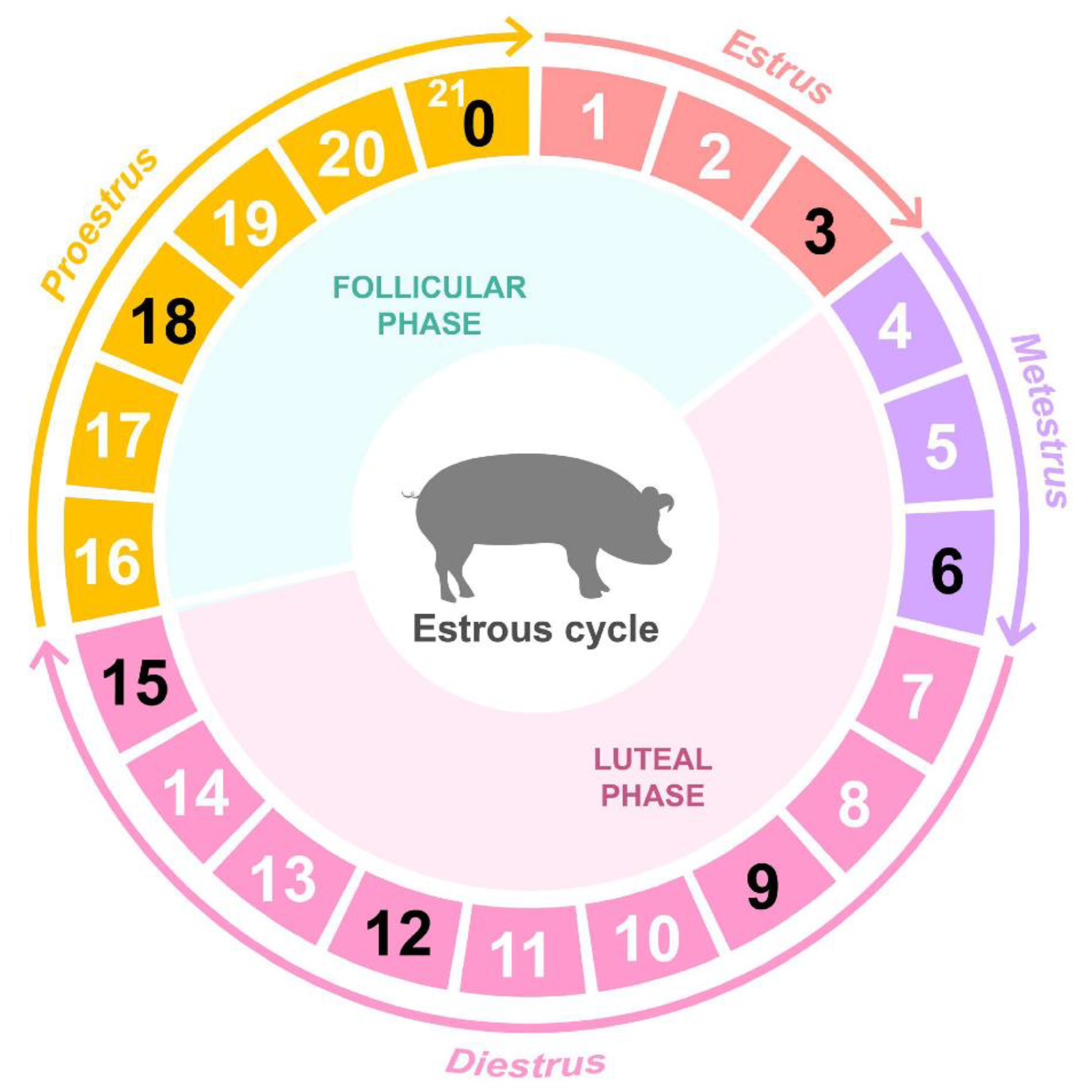


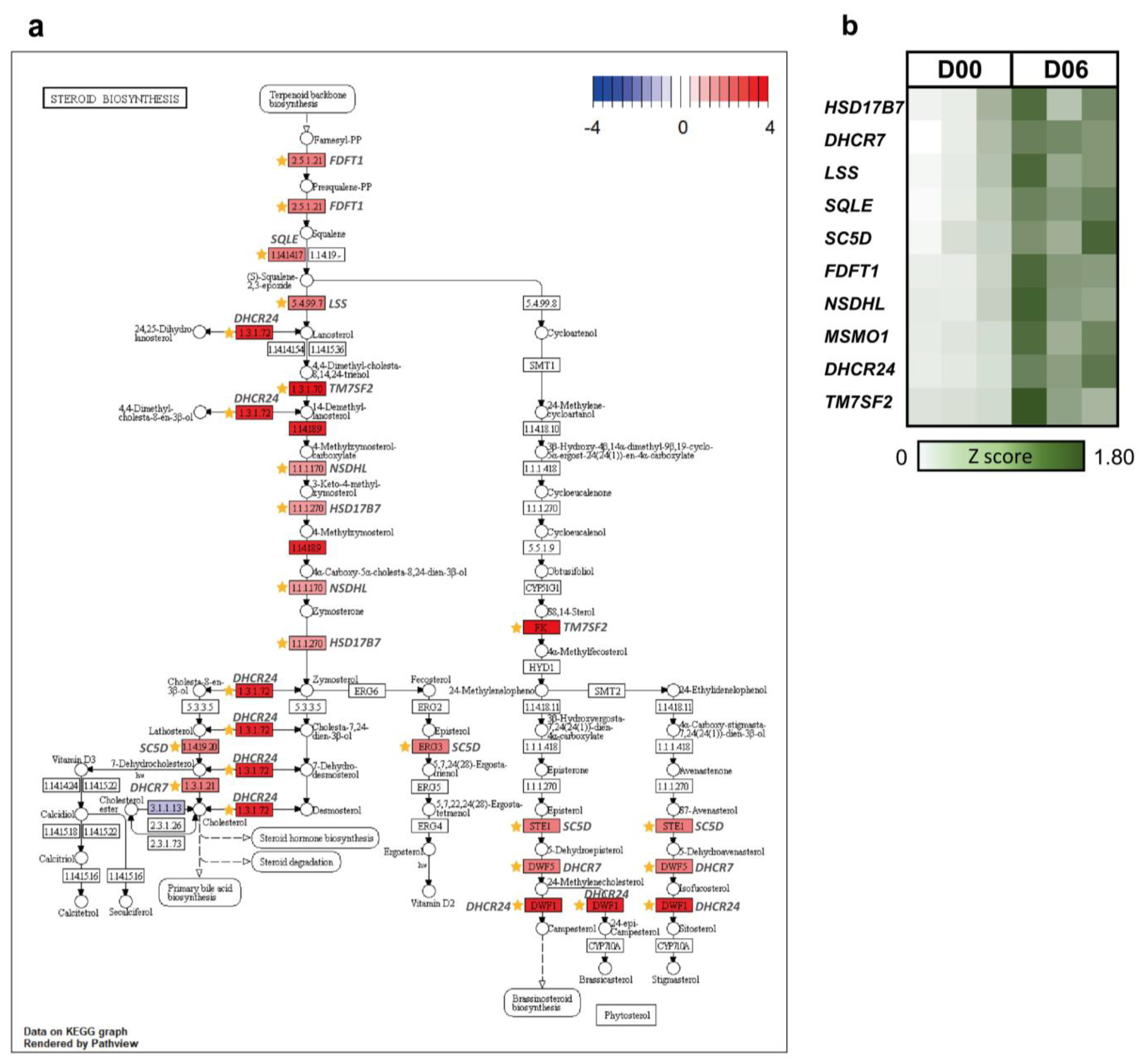
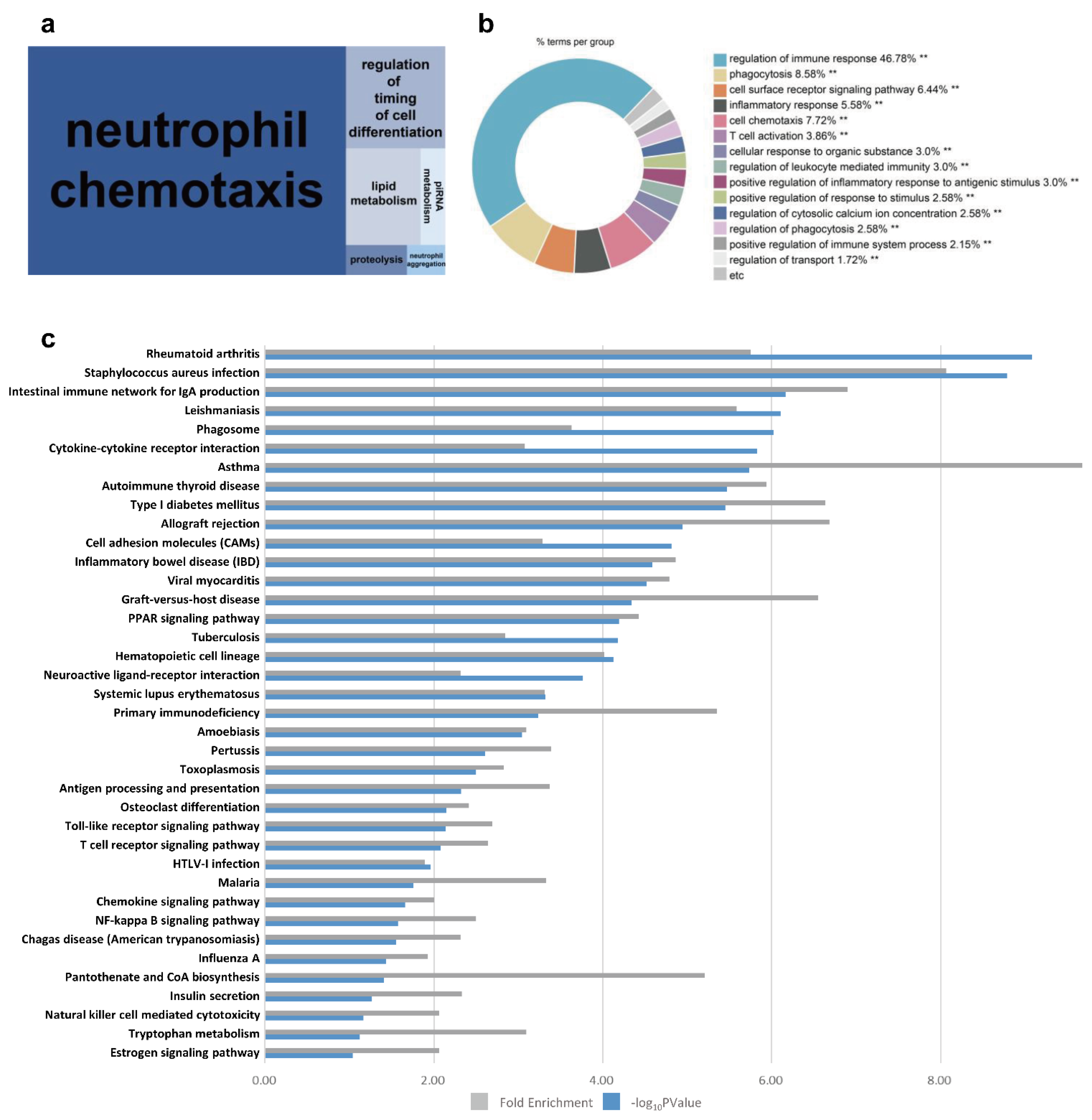
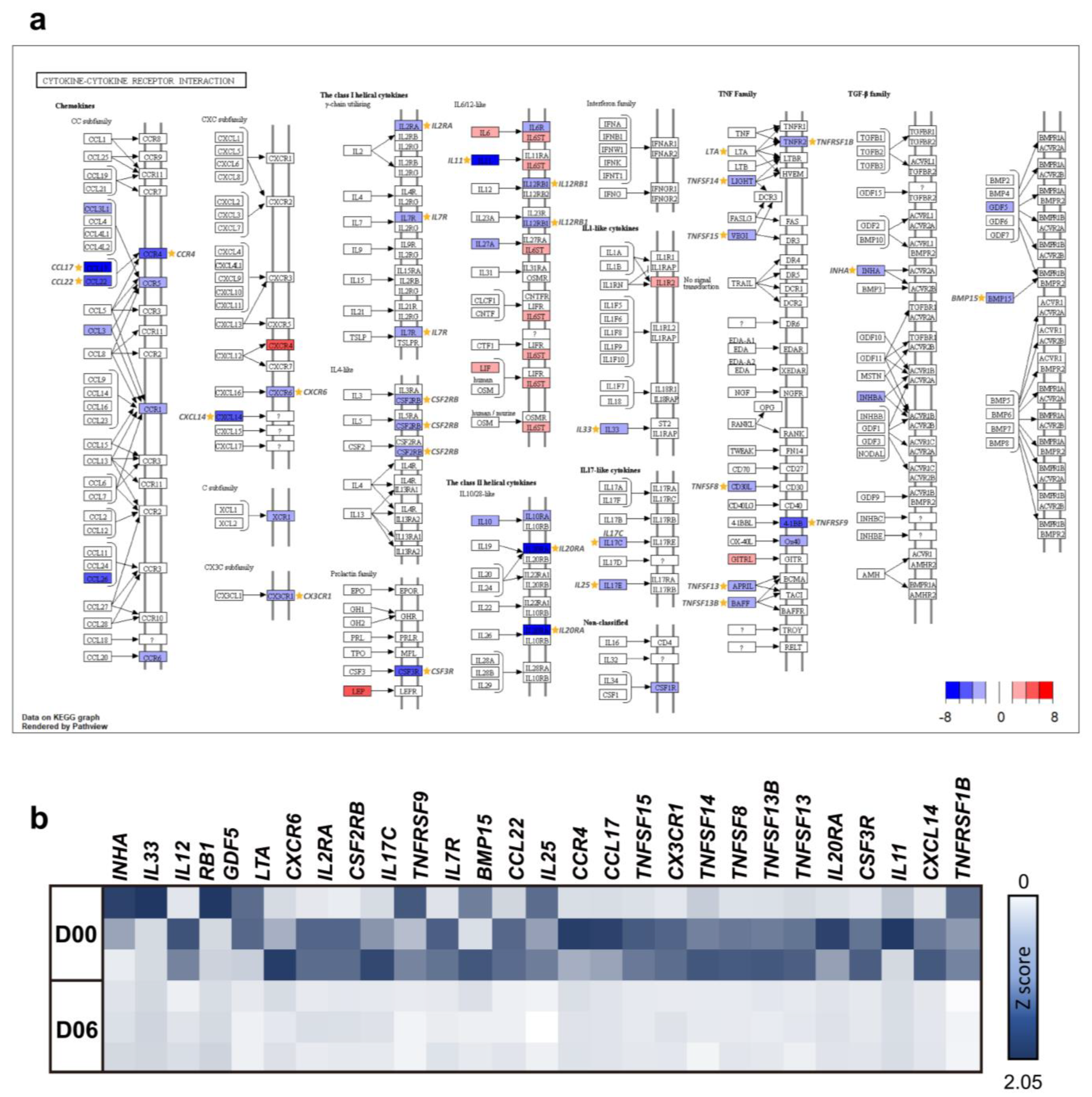
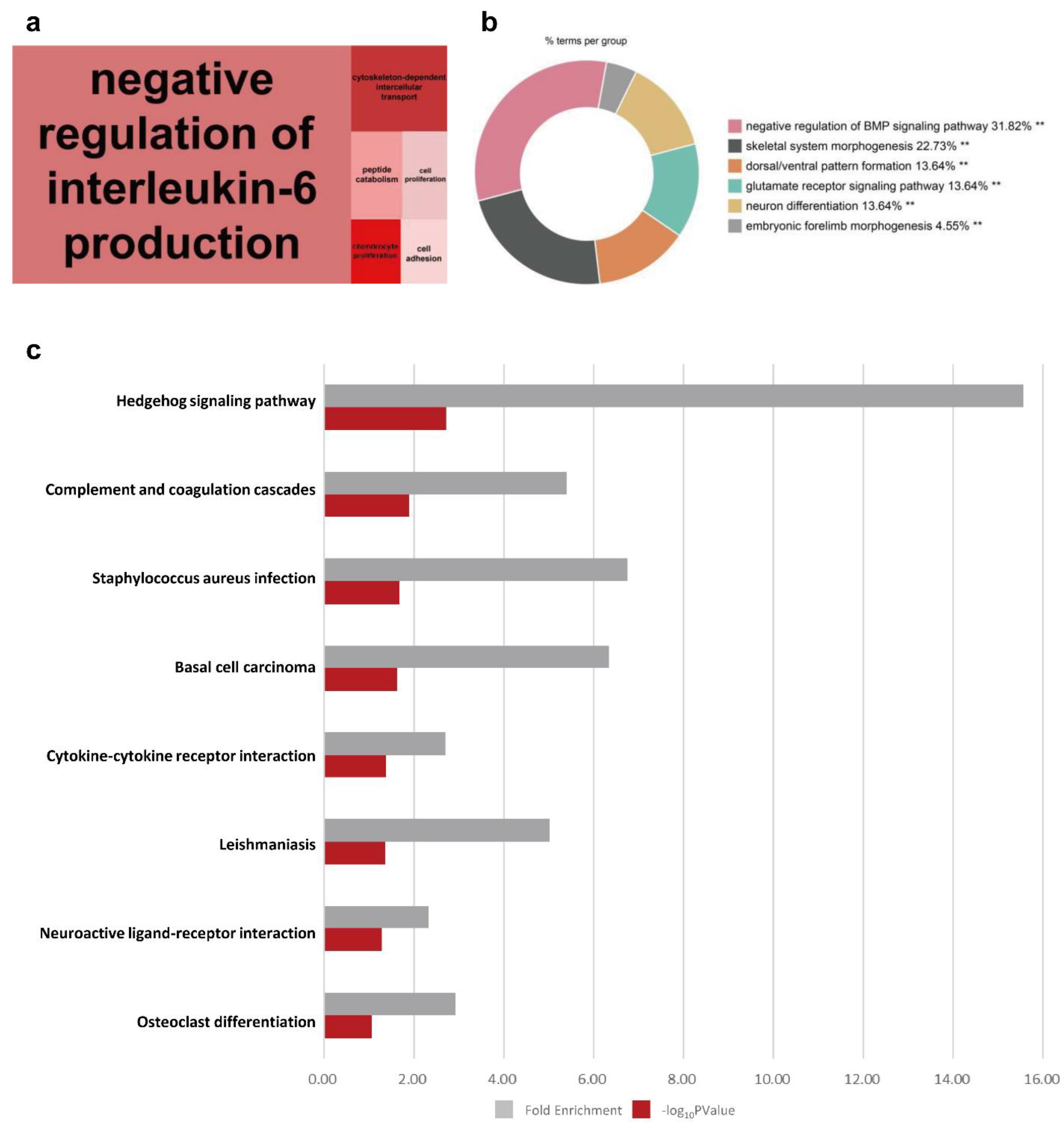
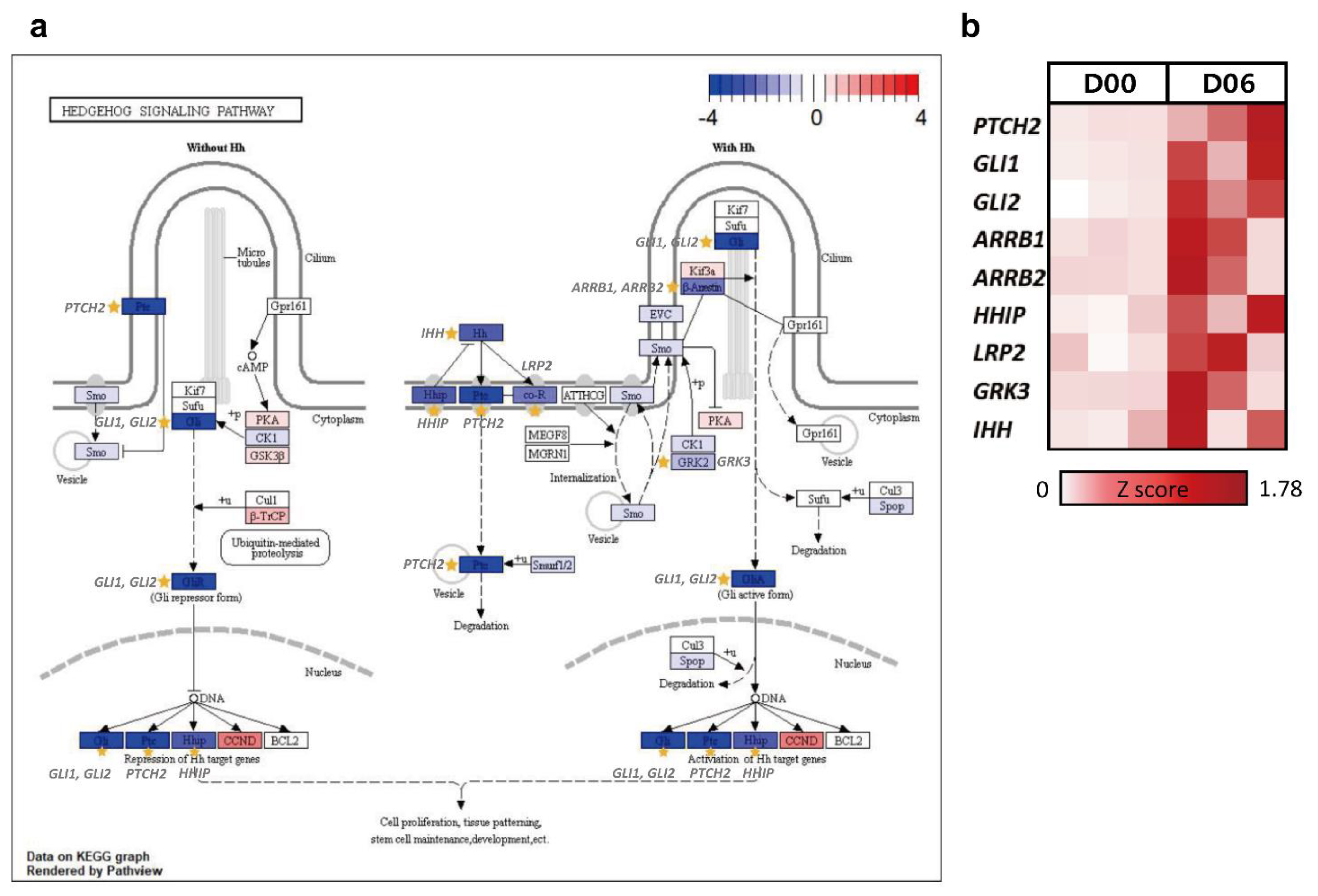
| Group | Sample | Raw Reads | Clean Reads Rate (%) | Uniquely Mapped Reads Rate (%) | Overall Alignment Rate (%) |
|---|---|---|---|---|---|
| Day 0 | D00C-Ovary-1 | 19,596,597 | 16,133,880 (82.33) | 95.12 | 98.36 |
| D00C-Ovary-2 | 19,851,794 | 16,852,302 (84.89) | 94.80 | 98.31 | |
| D00C-Ovary-3 | 19,119,940 | 16,298,225 (85.24) | 94.84 | 98.49 | |
| Day 3 | D03C-Ovary-1 | 18,523,866 | 15,737,437 (84.96) | 94.72 | 98.39 |
| D03C-Ovary-3 | 19,201,088 | 16,311,360 (84.95) | 94.83 | 98.46 | |
| Day 6 | D06C-Ovary-1 | 19,286,199 | 16,446,174 (85.27) | 94.93 | 98.56 |
| D06C-Ovary-2 | 20,334,817 | 17,479,844 (85.96) | 94.46 | 98.50 | |
| D06C-Ovary-3 | 21,255,422 | 18,276,501 (85.99) | 94.07 | 98.30 | |
| Day 9 | D09C-Ovary-1 | 19,901,123 | 17,088,002 (85.86) | 94.31 | 98.42 |
| D09C-Ovary-2 | 21,040,934 | 18,103,889 (86.04) | 94.10 | 98.45 | |
| D09C-Ovary-3 | 18,146,293 | 15,539,159 (85.63) | 94.47 | 98.45 | |
| Day 12 | D12C-Ovary-1 | 19,069,936 | 16,168,172 (84.78) | 94.84 | 98.45 |
| D12C-Ovary-2 | 18,537,734 | 15,955,652 (86.07) | 93.39 | 98.28 | |
| D12C-Ovary-3 | 18,664,749 | 16,005,643 (85.75) | 93.50 | 98.00 | |
| D12C-Ovary-4 | 17,946,020 | 15,377,254 (85.69) | 94.05 | 98.32 | |
| Day 15 | D15C-Ovary-1 | 18,858,268 | 15,953,501 (84.60) | 94.57 | 98.32 |
| D15C-Ovary-2 | 18,255,019 | 15,646,924 (85.71) | 94.56 | 98.34 | |
| D15C-Ovary-3 | 19,733,962 | 16,849,829 (85.38) | 94.55 | 98.28 | |
| D15C-Ovary-4 | 20,762,176 | 17,717,261 (85.33) | 94.47 | 98.17 | |
| Day 18 | D18C-Ovary-1 | 22,291,469 | 19,003,553 (85.25) | 94.67 | 98.31 |
| D18C-Ovary-2 | 19,663,920 | 16,727,802 (85.07) | 94.88 | 98.33 | |
| D18C-Ovary-3 | 19,968,688 | 17,000,527 (85.14) | 95.20 | 98.36 |
Publisher’s Note: MDPI stays neutral with regard to jurisdictional claims in published maps and institutional affiliations. |
© 2022 by the authors. Licensee MDPI, Basel, Switzerland. This article is an open access article distributed under the terms and conditions of the Creative Commons Attribution (CC BY) license (https://creativecommons.org/licenses/by/4.0/).
Share and Cite
Park, Y.; Park, Y.-B.; Lim, S.-W.; Lim, B.; Kim, J.-M. Time Series Ovarian Transcriptome Analyses of the Porcine Estrous Cycle Reveals Gene Expression Changes during Steroid Metabolism and Corpus Luteum Development. Animals 2022, 12, 376. https://doi.org/10.3390/ani12030376
Park Y, Park Y-B, Lim S-W, Lim B, Kim J-M. Time Series Ovarian Transcriptome Analyses of the Porcine Estrous Cycle Reveals Gene Expression Changes during Steroid Metabolism and Corpus Luteum Development. Animals. 2022; 12(3):376. https://doi.org/10.3390/ani12030376
Chicago/Turabian StylePark, Yejee, Yoon-Been Park, Seok-Won Lim, Byeonghwi Lim, and Jun-Mo Kim. 2022. "Time Series Ovarian Transcriptome Analyses of the Porcine Estrous Cycle Reveals Gene Expression Changes during Steroid Metabolism and Corpus Luteum Development" Animals 12, no. 3: 376. https://doi.org/10.3390/ani12030376
APA StylePark, Y., Park, Y.-B., Lim, S.-W., Lim, B., & Kim, J.-M. (2022). Time Series Ovarian Transcriptome Analyses of the Porcine Estrous Cycle Reveals Gene Expression Changes during Steroid Metabolism and Corpus Luteum Development. Animals, 12(3), 376. https://doi.org/10.3390/ani12030376






